- Qualcomm Launches Snapdragon 4 Gen 2 Mobile Platform
- AMD Launches Ryzen PRO 7000 Series Mobile & Desktop Platform
- Intel Launches Sleek Single-Slot Arc Pro A60 Workstation Graphics Card
- NVIDIA Announces Latest Ada Lovelace Additions: GeForce RTX 4060 Ti & RTX 4060
- Maxon Redshift With AMD Radeon GPU Rendering Support Now Available
Transcend SSD370S MLC SSD Review

Got that new laptop or desktop and want to start the new year off right with a solid-state drive upgrade? Need an SSD that will theoretically outlive every system you will ever own for the duration of your lifetime? If that’s the case then you’ve come to the right place as Transcend has the drive for you.
Page 2 – Test Suite, PC Mark, Iometer & AS SSD
Benchmark Programs
Futuremark PCMark 08: Normal settings are used including the default setting of three runs. This gives us an extended test that takes roughly 45 minutes to complete resulting in a sustained load that will thermally challenge drives. The free (demo) version is available on Steam for public use.
AS SSD: This handy little utility was custom-written for solid-state drives. We selected this program as by default it utilizes incompressible data and bypasses the Windows cache. This is another free program anyone can use to quickly test or verify normal performance of an SSD, available here.
ATTO: The bar graphs generated by this utility provide a huge amount of data in a condensed format. It is extremely handy for detecting problematic file sizes, performance bottlenecks, or simply inconsistent performance. Though this is significantly less of a problem today as solid-state drives have matured it is an essential piece of any benchmark kit.
RoboCopy: This is Windows command-line utility included in most versions of Windows and provides for features beyond the default file copy handling of Windows. More information is available here. Due to a quick in Windows caching tests are run once before the system is restarted to avoid caching problems. Windows Defender is also disabled to prevent bottlenecking the folder copy.We utilize a 9.81GB Movie file, and also a 1.6GB Folder with, 11,511 files across 449 subfolders.
RAMdrive: Primo Software’s Ramdisk utility is a handy, convenient way to create a 12GB direct-IO ramdisk meaning no indexing or caching is utilized. File performance varies by I/O size but exceeds 6GB/s above 16KB IOPS.
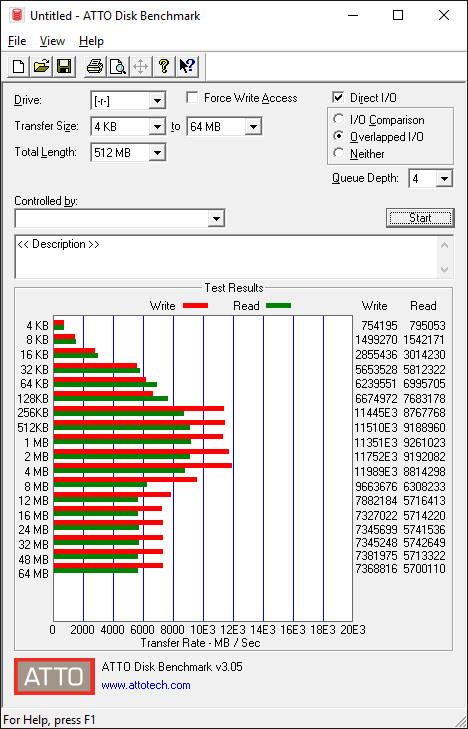
dBpoweramp R15.3: We convert 500 FLAC encoded music files (14.4GB) into Apple Lossless encoded files for playback on Apple devices. As no lossy compression is taking place this minimizes the CPU workload while maximizing the amount of data written to the destination drive. Unfortunately this test would show more variance in results for systems with greater than four cores as dBpoweramp will fully load any size processor.
IOmeter – The most powerful piece of storage testing software freely available, IOmeter allows the creation of practically any kind of test workload. We first utilize it to dirty every new SSD before we test the basics of every solid-sate drive, namely random 4K read and writes as well as 2MB sequential read and write performance.
Footnote – Disk I/O Tracing
If you are still reading our benchmark profile, thank you! It is not easy to devise tests that can tax a modern solid-state drive so if you have any suggestions or know of any software that you would like to see added to our test regimen please let us know. We are especially eager to add disk I/O trace recording and playback to replace the batch file testing we utilized in past storage reviews. We are still looking into how to make this possible, so if you know of a piece of software that is free or doesn’t cost a few grand please do drop us a note!
Futuremark PCMark 8
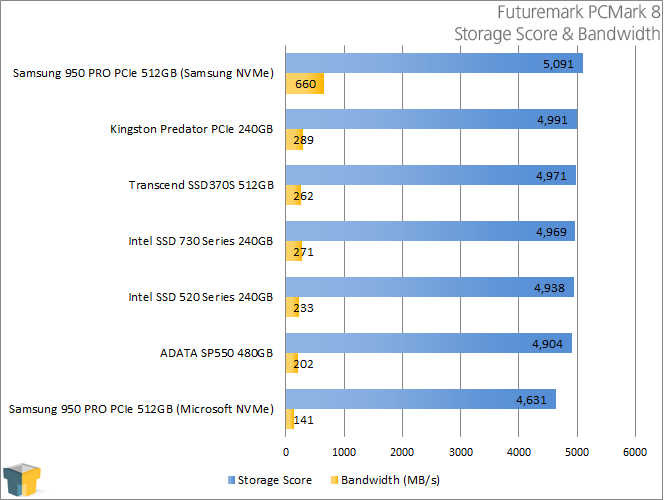
| ADATA SP550 | Transcend SSD370S | Intel 730 | Kingston Predator | Samsung 950 PRO (Samsung NVMe) | |
| World of Warcraft | 59s | 58s | 58s | 58s | 57s |
| Battlefield 3 | 134s | 133s | 133s | 133s | 131s |
| Photoshop Light | 114s | 114s | 115s | 112s | 110s |
| Photoshop Heavy | 374s | 360s | 364s | 355s | 351s |
| Adobe InDesign | 60s | 57s | 58s | 57s | 55s |
| Adobe After Effects | 71s | 71s | 70s | 71s | 70s |
| Adobe Illustrator | 72s | 72s | 72s | 72s | 71s |
| Microsoft Word | 28s | 28s | 28s | 28s | 28s |
| Microsoft Excel | 9s | 9s | 9s | 9s | 9s |
| Microsoft PowerPoint | 9s | 9s | 9s | 9s | 9s |
Immediately Transcend’s SSD370S is off with a bang, beating all other SATA drives in overall score. Though the SP550 features the same controller its use of TLC NAND holds it back despite the SLC caching feature.
Performance is even very close to that of the M.2 Predator which is no small feat given the higher bandwidth available on the M.2 interface. Load times either equal or exceed those of the SP550 with the largest gains in the heavy Photoshop test.
Iometer 2010 1.1.0
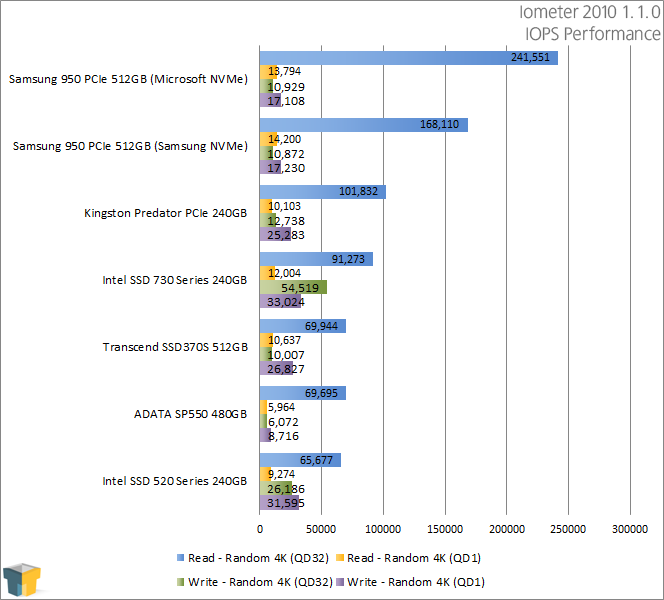
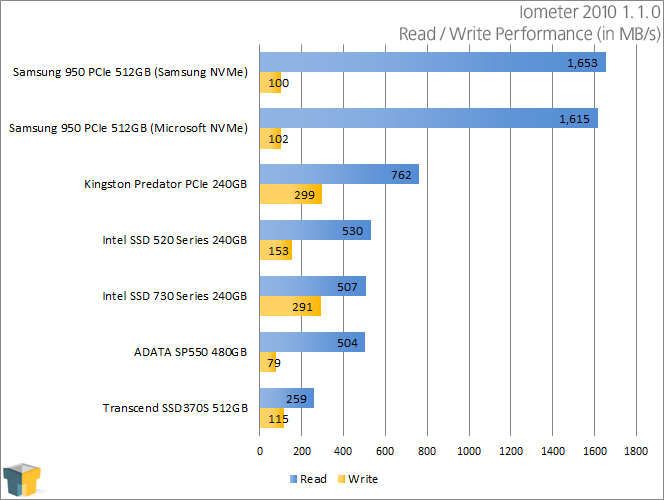
One thing to keep in mind is Iometer creates a test file that spans the entire size of the SSD. So it should come as no surprise that this effectively negates the SLC caching performance of the SP550. Because of this the SSD370S is able to easily exceed it in write performance, though for some unknown reason it didn’t like Iometer’s sequential read test.
Whether it is due to the SP550’s caching system or the SSD370S’s customized firmware the Transcend drive is able to scale much better delivering almost twice the performance of the SP550 in both the Random Read QD1 and Random Write QD32 tests. The Transcend performs even better at random low queue depth write operations.
AS SSD
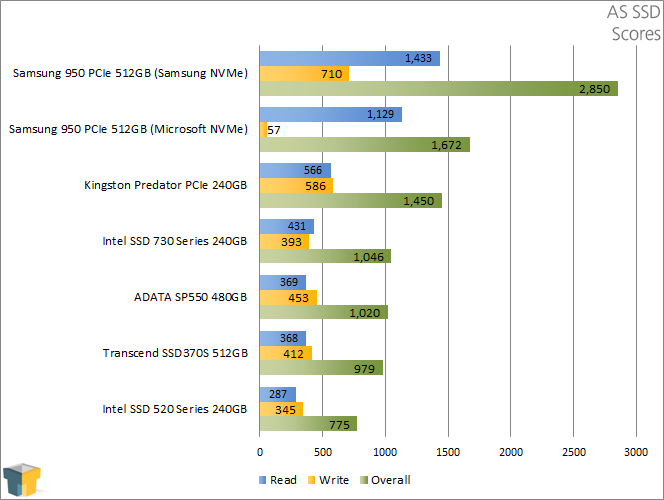
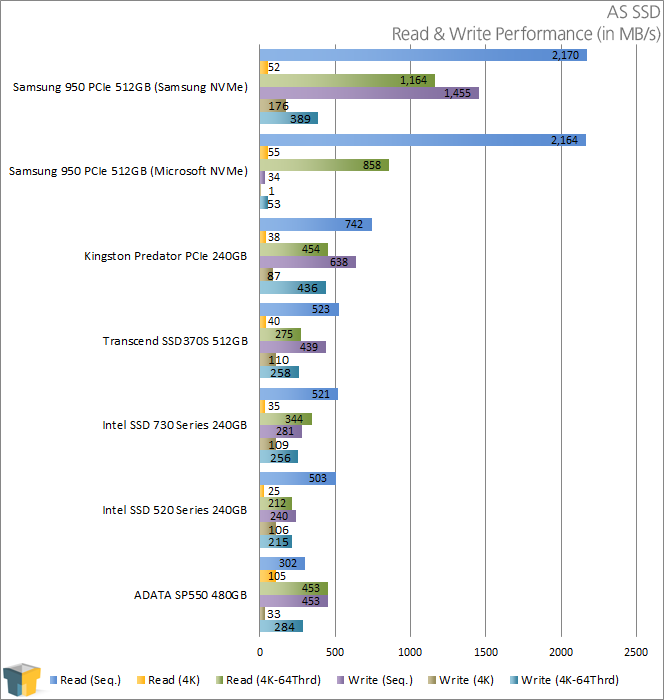
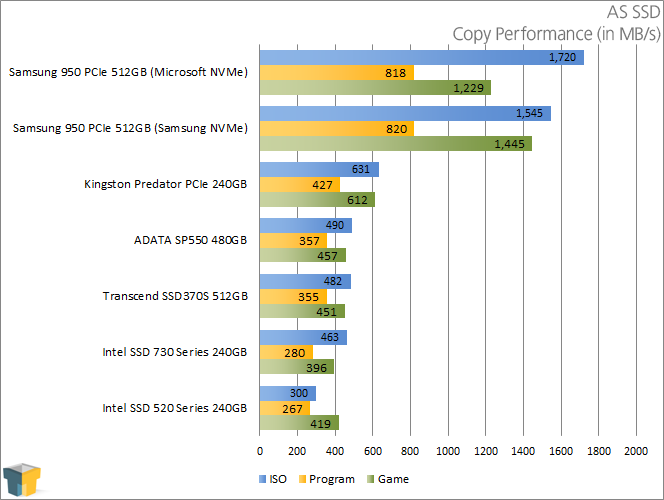
| AS SSD – Latencies | Read | Write |
| ADATA SP550 (480GB) | 0.035ms | 0.034ms |
| Intel 520 (240GB) | 0.110ms | 0.173ms |
| Intel 730 (240GB) | 0.032ms | 0.032ms |
| Kingston Predator (240GB) | 0.041ms | 0.047ms |
| Samsung 950 PRO (Microsoft NVMe) | 0.027ms | 2.670ms |
| Samsung 950 PRO (Samsung NVMe) | 0.023ms | 0.021ms |
| Transcend SSD370S (512GB) | 0.032ms | 0.035ms |
By default AS SSD uses a 1GB file for its test run and that is what we utilized in our tests, though this can be modified. The SSD370S is able to again easily best the SandForce 520 controller in raw scores, though the SP550 does manage to edge it out slightly due to its SLC cache buffering.
While the Transcend utilizes custom firmware it still shares the same physical controller as the SP550, which is probably why the two drives deliver virtually identical results in the copy performance testing. Read and write latencies are also effectively the same with the differences within the margin of error.
Support our efforts! With ad revenue at an all-time low for written websites, we're relying more than ever on reader support to help us continue putting so much effort into this type of content. You can support us by becoming a Patron, or by using our Amazon shopping affiliate links listed through our articles. Thanks for your support!




